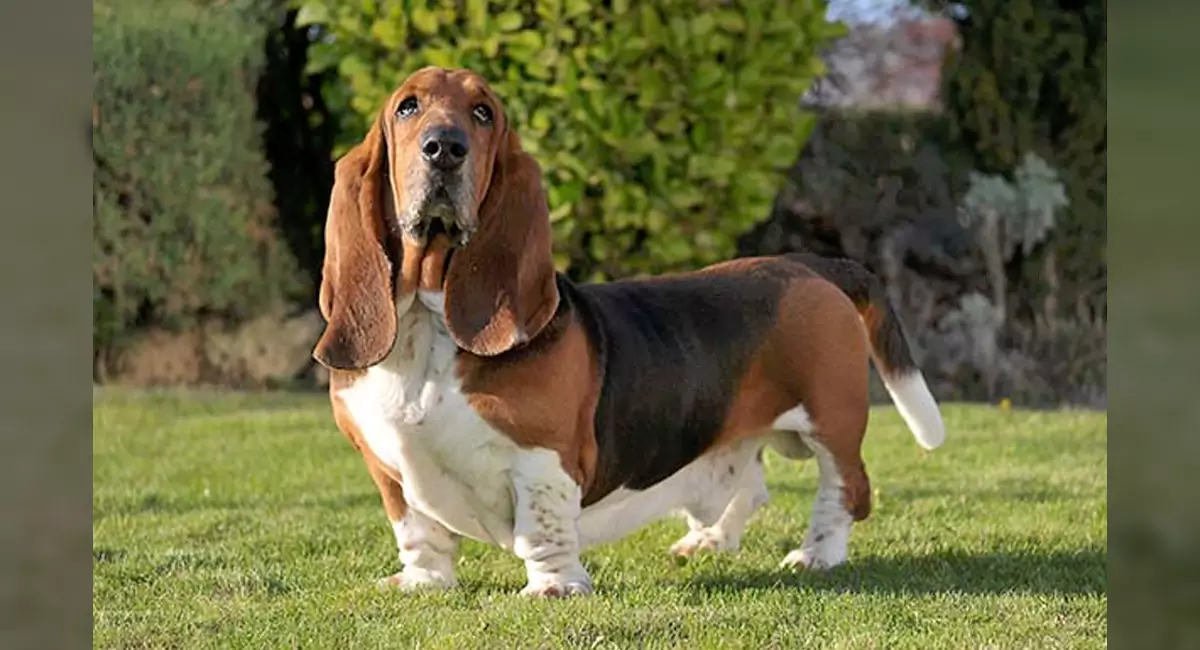
Basset Hound Dog Breed, Price, Lifespan, Temperament and Size
Basset Hound Dog Breed Overview
One of the most searched dog breeds on the internet, Basset Hound belongs to the medium size dog. Also known as Hush Puppy, this breed was discovered first in the France. The average lifespan of this dog breed is 10-12 years and is associated with the Hunting Dogs Group.
| Dog Breed Name: | Basset Hound |
|---|---|
| Other Names: | Hush Puppy Basset |
| Size: | medium size dog |
| Average Height: | Male: 12-15 inches (30-38 cm), Female: 11-14 inches (28-36 cm) |
| Average Weight: | Male: 50-65 pounds (23-29 kg), Female: 45-60 pounds (20-27 kg) |
| Energy: | Medium energy level |
| Origin: | France |
| Group: | Hound Dogs |
| Life Span: | 10 to 12 years |
| Dog Breed Overview: | Trust the French to develop such a distinctive breed, with its "jolie" appearance, jolie meaning pretty-ugly, or unconventionally attractive. The name Basset means "low" and in France it refers to a distinct level of hound by height.Bassets probably descended from the St. Hubert Hound, the ancestor of the present-day Bloodhound, and came about when a mutation in the St. Hubert strain produced a short-legged or dwarfed hound. Perhaps the dwarf hounds were kept as curiosities and later bred on purpose when their ability to track rabbits and hare under brush in thick forests was observed.The first recorded mention of a Basset Hound was in an illustrated book about hunting, La Venerie, written by Jacques du Fouilloux in 1585. From the illustrations, it appears that the early French Basset Hounds resembled the present-day Basset Artésien Normand, a dog breed today known in France.Basset Hounds were first popular with the French aristocracy, but after the French Revolution they became the hunting dogs of commoners who needed a dog they could follow on foot, not having access to horses. They made their way to Britain by the mid-19th century. Lord Galway imported a pair to England in 1866 and they produced a litter of five pups, but he didn't show them so they remained relatively unknown.Then, in 1874, Sir Everett Millais imported a Basset Hound named Model from France. Millais promoted the breed in England and started a breeding program in his own kennel as well as in cooperation with breeding programs established by Lord Onslow and George Krehl. For his efforts in gaining publicity for the Basset Hound in England, Millais is considered to be the "father of the breed" in England.He first exhibited a Basset at an English dog show in 1875, but it was not until he helped make up a large entry for the Wolverhampton show in 1880 that the public started to take note of the breed. A few years later, the breed became even more popular when Alexandra, Princess of Wales, kept Basset Hounds in the royal kennels. In 1882, the Kennel Club in England accepted the breed, and in 1884, the English Basset Hound Club was formed.Although the Basset probably came to America in colonial times, the breed did not come into its own in the U.S. until early in the 20th century. The American Kennel Club (AKC) began registering Basset Hounds in 1885, the first one being a dog named Bouncer, but it wasn't until 1916 that the AKC formally recognized the breed.The year 1928 was a turning point for the Basset Hound in America. In that year, Time magazine featured a Basset Hound on the front cover and ran an accompanying story about the 52nd annual Westminster Kennel Club Dog Show at Madison Square Garden written as if it was through the eyes of a Basset Hound puppy. The Basset Hound's charm was discovered, and from that point on, the Basset Hound started growing in popularity.Bassets entered pop culture in a big way in the 1960s with their appearance in the advertising campaign for Hush Puppy shoes and the debut of the Fred Basset comic strip, which still runs today. The Basset Hound is currently ranked 28th among the 155 breeds and varieties registered by the AKC, a testament to his enduring popularity.All throughout the U.S., Basset Hound people celebrate their love of the breed in ways that are as unique as their dogs' looks. Basset Hound picnics and waddles are traditions in many regions, sometimes drawing thousands of Bassets and their families.Some of these events even crown King and Queen Basset Hounds. Most hold such fun competitions as contests to determine which Basset has the best "waddling butt." These events usually have a wide variety of Basset Hound memorabilia, which often are sold to raise money for Basset Hound rescue organizations.France from the remnants of the now extinct Grand Fauve de Bretagne, a much larger breed. Dogs of this newer breed were hunting dogs in early France.This dog breed was used by French commoners to help them hunt after the French revolution. Because they hunted on foot, they needed a slower dog who could track and hunt game but also move at a speed that would allow people to keep up with them.The Basset Fauve de Bretagne is a great breed. If you want to bring home one of these special pups, consider adoption.Check your local shelters, look up Basset Fauve de Bretagne rescues in your area or check breed-specific hound rescues, as they sometimes take in these dog breeds and find forever homes for them." |
| Colours: | Tan,Gray,Tricolor,Brown,Red,White,Black |
| Temperament: | Affectionate,Friendly,Sweet,Tempered,Devoted,Gentle,Tenacious |
| Pros: |
|
| Cons: |
|
Basset Hound Dog Breed Price
Basset Hound from regular breeders cost you from $300 to $500 per puppy.
Basset Hound Dog Breed Size
The Basset Hound varies in size: males are normally 13-15 inches (32-38 cm) in height and around 25-35 pounds (11-16 kg) in weight, while females are normally around 13-15 inches (32-38 cm) in height and 25-35 pounds (11-16 kg)in weight.
Basset Hound Dog Breed Temperament
The basset hound is a friendly, easygoing dog. Originally hunting in packs, they tend to be good with other dogs and other pets in general. Bassets are people oriented and get along well with children. Fairly smart dogs, bassets are not easy to train as they are somewhat stubborn.
Basset Hound Dog Breed Lifespan
The average lifespan for an Basset Hound is 10 to 12 years. That’s because these are medium-sized dogs with a good mix of genes in their blood.
Interesting Facts about Basset Hound Dog
- Like all hounds, Bassets can be stubborn and difficult to train and housetrain. Crate training is recommended.
- If they catch an interesting scent, Basset Hounds may try to follow it, no matter how much danger it poses to them. Keep your Basset on leash when outside and not in a fenced yard. Also, take him to obedience class and be sure he responds well to the Come command. Use gentleness and patience to train him. Hounds of all types typically think for themselves and don’t respond well to harsh training techniques.
- One of the primary reasons that Basset Hounds are given up to rescue or for adoption is that they “drool too much.” Because of the loose skin around their mouths, they also tend to make quite a mess when they drink. If you’re a fastidious housekeeper who can’t stand drool, a Basset Hound is not the best choice for you.
- Basset Hounds often have flatulence. If this problem seems excessive, talk to your vet. A change in diet may help.
- Obesity is a real problem for Basset Hounds. They love to eat and will overeat if given the chance. If they put on too much weight, they can begin to have joint and back problems. Portion out food relative to your Basset’s condition, not by the recommendation on the bag or can.
- Because Basset Hounds are prone to bloat (a potentially fatal condition), it’s better to feed them two or three smaller meals a day rather than one large meal a day. Don’t allow your Basset to exercise too strenuously after eating, and watch him for about an hour after eating to make sure he’s okay.
- Your Basset’s long ears need to be checked and cleaned each week to help prevent ear infections. You may find that you need to wash the ear flaps even more often, because they can drag in puddles and pick up dirt as they drag the ground.
- Basset Hounds can howl loudly, especially if they are left along for long periods of time.
- Even though your Basset Hound is strong and amazingly agile for having such short legs, it’s best to discourage him from jumping, for example, out of a car. Pick him up and support his back to ensure he doesn’t get hurt.
- Basset puppies can suffer from joint problems as they grow. Try not to allow your puppy to overdo things when he plays and discourage him from jumping on and off furniture.
- With two-thirds of their body weight in the front of their bodies, Basset Hounds are not great swimmers. Don’t allow your Basset Hound to fall into a swimming pool because he can quickly get into trouble.
FAQ’s on Basset Hound Dog
Are Basset Hound Dangerous Dogs? Are Basset Hound naturally aggressive?
Are they a potentially dangerous breed? No, Basset Hounds are not particularly aggressive dogs. In fact, they are often regarded as gentle, sweet, and sometimes even lazy. They tend to get along well with all members of the family, including small children and other pets.
Are Basset Hound smart?
Yes, Basset Hound are a highly intelligent dog breed.
Are Basset Hound trainable?
They are highly trainable, have the ability to learn complicated tasks, and perform excellently as search and rescue dogs.
Can Basset Hound be kept with other dogs?
The basset hound is a friendly, easygoing dog. Originally hunting in packs, they tend to be good with other dogs and other pets in general. Bassets are people oriented and get along well with children.
Can a Basset Hound attack its owner?
Basset Hounds are so notoriously laidback and non-aggressive that they don’t even make very good guard dogs: they might bark at strangers, but they are unlikely to attack anyone of their own accord, even if they are suspicious of them.
Do Basset Hound have locking jaws?
No, they do not have locking jaws.
Are Basset Hound safe to keep with kids?
The basset hound is a friendly, easygoing dog. Originally hunting in packs, they tend to be good with other dogs and other pets in general. Bassets are people oriented and get along well with children.
What should I feed my Basset Hound?
Adult Basset Hounds will do well on a complete and balanced dog food. Basset Hound puppies should eat a complete and balanced puppy food for their first year of life. Puppy food has all the essential nutrients Bassets need for their growth and development.
At what age is a Basset Hound fully grown?
At what age is a Basset Hound fully grown? Like all dogs, Basset Hounds are considered adults at a year old. However, they typically need at least 16 months to reach their full size. Larger Basset Hounds may require a full two years to fill out their chest completely.
When do Basset Hound lose their teeth?
6 Months and Older: By the time, your puppy is about six months old or so, all of his puppy teeth should have fallen out, and his adult teeth should have grown in. In general, adults dogs have about 42 teeth (fun fact: that’s about 10 more than people.
How long does a Basset Hound live?
A Basset Hound can live anywhere from 10 to 12 years.

